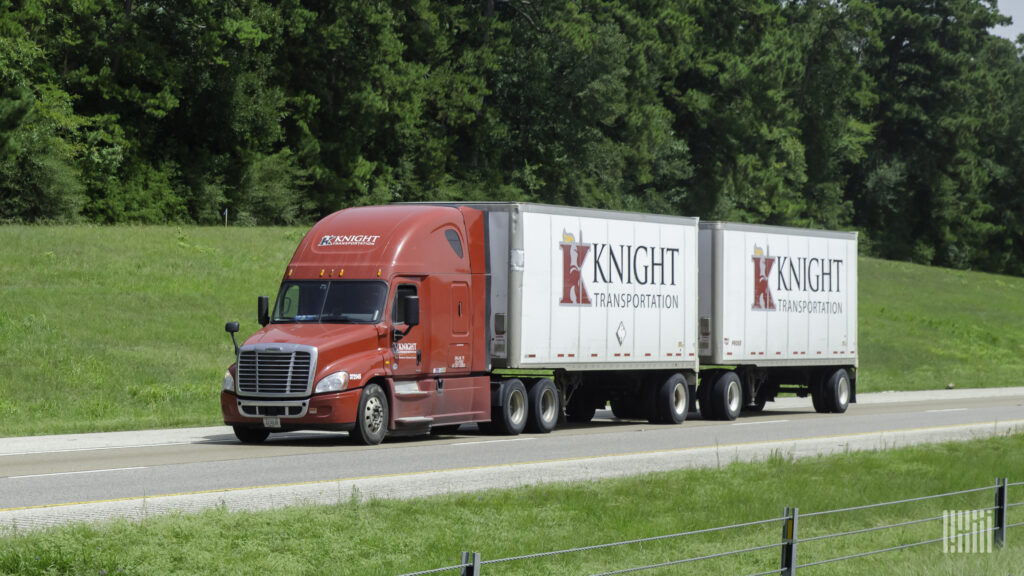Knight-Swift Transportation Holdings Inc. released its third-quarter financial results on October 19, showing a significant 69% decrease in earnings compared to the same period last year. Interestingly, while their profits took a hit, their total revenue actually went up.
The truckload carrier, headquartered in Phoenix, reported a net income attributable to its operations of $60.2 million, which equates to 37 cents per diluted share. In contrast, the previous year’s Q3 figures were much higher, with earnings of $194.8 million, or $1.21 per share. Nevertheless, there was a positive note in the report, as the company’s total revenue showed a healthy 6.5% increase, reaching $2.02 billion, compared to the previous year’s $1.9 billion.
“We continue to be in a depressed truckload freight market where rate expectations from shippers are often close to, if not below, operating costs,” Knight-Swift CEO David Jackson said during a conference call with investors. “Spot rates are not at sustainable levels and are proving not to be survivable for those that are dependent on that type of freight.”
Jackson stated that the company is nearing a critical turning point in its operations. This transition involves shippers exerting pressure to lower rates while, simultaneously, concerns about available capacity are beginning to emerge in the market.
“We are not seeing enough of that kind of activity — enough supply leave and/or enough strength in volumes to move rates to a meaningful inflection position — right now,” Jackson said, “but it does appear that the stage is being set for positive rate pressure in the next bid season.”
Jackson outlined three primary objectives he is actively pursuing. These goals include enhancing the performance of Knight-Swift’s truckload division, expanding the less-than-truckload segment, and orchestrating a revival at U.S. Xpress Enterprises, a company recently acquired by Knight-Swift earlier this year.
“There’s much in our control that we can do, including being better at cost, running more miles safely and in hiring and retaining driving associates,” Jackson said. “Our people are digging in and working hard, we’re grateful for that.”
The company’s third-quarter results presented a mixed picture in relation to what Wall Street had anticipated. Analysts were expecting earnings per share (EPS) of 39 cents and quarterly revenue of $1.92 billion, as per the Zacks Consensus Estimate.
Within the Knight-Swift truckload segment, the third quarter saw a significant 21.9% increase in revenue, reaching $1.18 billion, compared to $967.8 million in the previous year. However, this segment grappled with challenging market conditions, including weakening demand and ongoing rises in fuel prices. Operating income, in contrast, decreased by a substantial 72.5%, falling from $175.8 million the previous year to $48.4 million. This segment encompasses various truckload operations such as irregular route truckload, dedicated truckload, refrigerated, expedited, flatbed, and cross-border services.
Although the adjusted operating ratio for this segment improved slightly in the third quarter due to cost-cutting measures, Jackson expressed his dissatisfaction with the current state of affairs. “The truckload operating ratio excluding U.S. Xpress was at 91.5 and we are just simply not comfortable with an OR that starts with a 9,” he said.
The operating ratio is a key metric that assesses a company’s efficiency by measuring its expenses as a percentage of its revenue. It serves as an indicator of a company’s ability to generate profits. When the ratio is lower, it signifies the company’s greater profitability potential. An operating ratio below 100 suggests the company can generate profits, whereas a ratio above 100 indicates that the company is not producing enough revenue to sustain profitability after covering all its expenses.
In the case of the company’s Less-Than-Truckload (LTL) segment, there was a notable 6.9% increase in revenue, reaching $240 million compared to the previous year’s $224.4 million. The report highlighted that this growth in revenue was a consequence of disruptions in the industry, leading to an increase in volumes. However, these gains were somewhat offset by rising wages and increased labor costs required to maintain service levels throughout the quarter.
The operating income for the LTL segment also saw an uptick, rising by 4.6% to $32.3 million, compared to $30.9 million in the previous year.
On the other hand, the logistics segment faced different challenges. It reported a 24.5% decrease in revenue, which dropped from $210 million to $158.6 million. This decline was attributed to shrinking gross margins during the third quarter, as upward pressure on pricing at the top line was not being adequately offset by corresponding reductions in purchased transportation costs. Consequently, the operating income for the logistics segment plummeted by 62.3%, falling from $27.5 million to $10.4 million.
In the intermodal segment, there was a noticeable 22.6% drop in revenue, which decreased from $130.8 million to $101.2 million. Despite experiencing a 5.5% year-over-year increase in load count, revenue per load saw a significant decline of 26.6%. This decrease was primarily a result of weak demand and intense competition in the trucking capacity market.
To mitigate the impact of declining volume and prices, the company implemented improved pricing strategies with its rail partners during the quarter. This helped to somewhat offset the declines in volume and pricing, leading to a modest improvement in the operating margin. However, despite these efforts, the third-quarter operating income showed a substantial decline, falling by 135.3% to a loss of $4.52 million, compared to a gain of $12.83 million in the previous year.
TD Cowen analyst Jason Seidl said the carrier’s Q3 results were “in line with our estimate.” In a report, he added, “Tightened guidance points to sequential improvement in Q4, albeit off a low base.”





